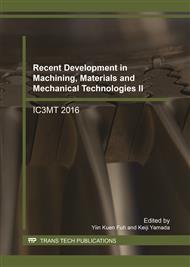p.70
p.76
p.81
p.87
p.94
p.101
p.107
p.111
p.118
Study on Tool Wear In-Process Estimation for Ball End Mill Using Rotation Control Air Turbine Spindle
Abstract:
This paper introduces a method for in-process tool wear estimation of an air turbine spindle, which is equipped with a rotation control system for ultra-precision milling. Previous investigations revealed that the pressure of the compressed air for supply that is used to control the rotational speed and tool wear at the time when steady wear occurs, maintains a linear relationship when processing SKD61 steel. In addition, the extent to which the supply pressure changed was reduced after chipping occurred. Therefore, the possibility exists that the tool wear can be estimated by obtaining the supply pressure during processing. The purpose of this paper is to propose the evaluation of an in-process tool wear estimation method, and to evaluate its validity. An estimation method is necessary as this would allow the amount of tool wear to be estimated and abnormal wear of occurrence to be detected. Because of the linear relationship between the air pressure and the amount of tool wear, the latter can be estimated by plotting the approximately linear relationship of the tool wear as a function of the air pressure. The proposed estimation method for processing the results obtained for SKD61, is capable of estimating the relative error of the measured value within 0.2 against the estimated value at the time. Furthermore, the occurrence of abnormal wear is determined from the amount of change in the supply pressure. Thus, SKD11 steel was processed for the proposed estimation method to verify whether it is valid for cutting high hardness steel. As a result, for SKD11 the estimation method produced estimation results similar to those obtained for SKD61. Therefore, the suggested estimation method is likely to be effective for high-hardness steel cutting.
Info:
Periodical:
Pages:
94-100
Citation:
Online since:
August 2017
Keywords:
Price:
Сopyright:
© 2017 Trans Tech Publications Ltd. All Rights Reserved
Share:
Citation:


